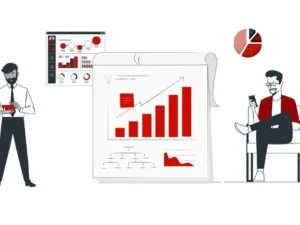- Description
- Curriculum
- Reviews
Requirements
Only Basic Python Programming knowledge is required
You can use any IDE like Jupyter Notebook or Google Colab etc for coding
All source codes and datasets are freely available to download
Interest in Data Analytics / Data Science / Python
Description
In this comprehensive course, we present to you 9 meticulously crafted Data Analytics projects, meticulously solved using Python, a language renowned for its versatility and effectiveness in the realm of data analysis.
These projects serve as an invaluable resource for individuals embarking on their journey towards a career as a Data Analyst, offering practical insights and hands-on experience essential for success in the field.
Moreover, for those contemplating a transition into the dynamic and rewarding domain of data analytics, these projects provide a solid foundation, equipping learners with the requisite skills and knowledge to navigate the complexities of real-world data analysis scenarios with confidence and proficiency.
Designed with students in mind, these projects are not only educational but also serve as potential submissions for academic institutions. By working through these projects, students can demonstrate their proficiency in data analysis techniques and enhance their academic credentials.
As part of our commitment to fostering a supportive learning environment, we provide access to the source code and datasets for all projects, enabling learners to delve deeper into the material and reinforce their understanding through hands-on experimentation.
Each project is accompanied by clear and concise explanations, ensuring accessibility for learners of all levels. Whether you’re a novice exploring the fundamentals of data analysis or a seasoned professional seeking to expand your skill set, you’ll find these projects to be both engaging and enlightening.
Central to the completion of these projects is the utilization of the Python Pandas Library, a powerful toolset for data manipulation and analysis. By leveraging the capabilities of Pandas, learners gain practical experience in handling and analysing data efficiently, setting the stage for success in their future endeavours.
For further elucidation on the concepts and techniques covered in each project, we encourage learners to peruse the descriptions provided for each video lecture, where additional insights and guidance await.
Now, let’s delve into the diverse array of projects awaiting you:
Project 1 – Weather Data Analysis
Project 2 – Cars Data Analysis
Project 3 – Police Data Analysis
Project 4 – Covid Data Analysis
Project 5 – London Housing Data Analysis
Project 6 – Census Data Analysis
Project 7 – Udemy Data Analysis
Project 8 – Netflix Data Analysis
Project 9 – Sales Data Analysis
Some examples of commands used in these projects are :
* reset_index() – To convert the index of a Series into a column to form a DataFrame.
* loc[ ] – To show any row’s values.
* info() – To provide the basic information about the dataframe.
* drop() – To drop any column or row from the dataframe.
* str.strip().str.replace(r’\s+’, ‘ ‘, regex=True) – To remove extra spaces in any text column.
* duplicated() – To show all the duplicate records from a dataframe.
* drop_duplicates(inplace=True) – To remove the duplicate records from the dataframe.
* round() – To round-off the values of a numerical column.
* to_datetime() – To convert the datatype of date column into datetime format.
* groupby() – To make the group of all unique values of a column.
* std() – To check the standard deviation of any numerical column.
* var() – To check the variance of any numerical column.
* mean() – To check the mean of any numerical column.
* agg() – Using agg() with groupby().
* head() – It shows the first N rows in the data (by default, N=5).
* columns – To show all the column names of the dataframe.
* unique() – In a column, it shows all the unique values. It can be applied on a single column only, not on the whole dataframe.
* nunique() – It shows the total no. of unique values in each column. It can be applied on a single column as well as on the whole dataframe.
* describe() – To show some summary about the columns.
* astype() – To change the datatype of any column.
* dtype – To check the datatype of any column.
* value_counts – In a column, it shows all the unique values with their count. It can be applied on a single column only.
* plot(kind=’bar’) – To draw the bar graph.
* type() – To the type of any variable.
* plt.figure(figsize = ()) – To set the size of any figure.
* plt.title(), plt.xlabel(), plt.ylabel() – To set the Title, x-axis label, y-axis label.
* sort_values(ascending = False) – To sort the values in descending order.
* dt.month – To create a new column showing Month only.
* shape – It shows the total no. of rows and no. of columns of the dataframe
* index – This attribute provides the index of the dataframe
* dtypes – It shows the data-type of each column
* count – It shows the total no. of non-null values in each column. It can be applied on a single column as well as on the whole dataframe.
* isnull( ) – To show where Null value is present.
* dropna( ) – It drops the rows that contains all missing values.
* isin( ) – To show all records including particular elements.
* str.contains( ) – To get all records that contains a given string.
* str.split( ) – It splits a column’s string into different columns.
* dt.year.value_counts( ) – It counts the occurrence of all individual years in Time column.
* sns.countplot(df[‘Col_name’]) – To show the count of all unique values of any column in the form of bar graph.
* max( ), min( ) – It shows the maximum/minimum value of the series
Through these projects and commands, learners will not only acquire essential skills in data analysis but also gain a deeper understanding of the underlying principles and methodologies driving the field of data analytics. Whether you’re pursuing a career as a Data Analyst, seeking to enhance your academic portfolio, or simply eager to expand your knowledge and skills in Python-based data analysis, this course is tailored to meet your needs and aspirations.
Who this course is for:
Anyone looking for Data Analyst job
Students looking for Data Analytics Projects
Beginner & Intermediate Python Programmers
Anyone wants to enhance big data analysis skills









